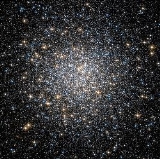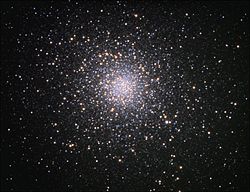
Messier 5
Encyclopedia
Messier 5 or M5 is a globular cluster
in the constellation
Serpens
. It was discovered by Gottfried Kirch
in 1702. It should not be confused with the much fainter and more distant globular cluster Palomar 5
, which is situated nearby in the sky.
5 Serpentis. Binoculars
or small telescope
s will identify the object as non-stellar while larger telescopes will show some individual stars, of which the brightest are of apparent magnitude
12.2.
M5 was discovered by the German astronomer Gottfried Kirch in 1702 when he was observing a comet
. Charles Messier
also noted it in 1764, but thought it a nebula without any stars associated with it. William Herschel
was the first to resolve individual stars in the cluster in 1791, counting roughly 200.
 Spanning 165 light-years in diameter, M5 is one of the larger globular clusters known. The gravitational sphere of influence of M5, (i.e. the volume of space in which stars are gravitationally bound to it rather than being torn away by the Milky Way
Spanning 165 light-years in diameter, M5 is one of the larger globular clusters known. The gravitational sphere of influence of M5, (i.e. the volume of space in which stars are gravitationally bound to it rather than being torn away by the Milky Way
's gravitational pull) has a radius of some 200 light-years.
At 13 billion years old it, M5 is also one of the older globulars associated with the Milky Way Galaxy. Its distance is about 24,500 light-years from Earth and the cluster contains more than 100,000 stars, as many as 500,000 according to some estimates.
in brightness, 97 of them belonging to the RR Lyrae
type. RR Lyrae stars, sometimes referred to as "Cluster Variables", are somewhat similar to Cepheid type variables
and as such can be used as a tool to measure distances in outer space since the relation between their luminosities and periods are well known. The brightest and most easily observed variable in M5 varies from magnitude 10.6 to 12.1 in a period of just under 26.5 days.
A dwarf nova
has also been observed in this cluster.
Globular cluster
A globular cluster is a spherical collection of stars that orbits a galactic core as a satellite. Globular clusters are very tightly bound by gravity, which gives them their spherical shapes and relatively high stellar densities toward their centers. The name of this category of star cluster is...
in the constellation
Constellation
In modern astronomy, a constellation is an internationally defined area of the celestial sphere. These areas are grouped around asterisms, patterns formed by prominent stars within apparent proximity to one another on Earth's night sky....
Serpens
Serpens
Serpens is a constellation of the northern hemisphere. It was one of the 48 constellations listed by the 2nd century astronomer Ptolemy and it remains one of the 88 modern constellations defined by the International Astronomical Union....
. It was discovered by Gottfried Kirch
Gottfried Kirch
Gottfried Kirch was a German astronomer. The son of a shoemaker in Guben, Electorate of Saxony, Kirch first worked as a calendar-maker in Saxonia and Franconia. He began to learn astronomy in Jena, and studied under Hevelius in Danzig...
in 1702. It should not be confused with the much fainter and more distant globular cluster Palomar 5
Palomar 5
Palomar 5 is a globular cluster discovered by Walter Baade in 1950. It was independently found again by Albert George Wilson in 1955. After the initial name of Serpens, it was subsequently catalogued as Palomar 5....
, which is situated nearby in the sky.
Discovery and visibility
M5 is, under extremely good conditions, just visible to the naked eye as a faint "star" near the starStar
A star is a massive, luminous sphere of plasma held together by gravity. At the end of its lifetime, a star can also contain a proportion of degenerate matter. The nearest star to Earth is the Sun, which is the source of most of the energy on Earth...
5 Serpentis. Binoculars
Binoculars
Binoculars, field glasses or binocular telescopes are a pair of identical or mirror-symmetrical telescopes mounted side-by-side and aligned to point accurately in the same direction, allowing the viewer to use both eyes when viewing distant objects...
or small telescope
Telescope
A telescope is an instrument that aids in the observation of remote objects by collecting electromagnetic radiation . The first known practical telescopes were invented in the Netherlands at the beginning of the 1600s , using glass lenses...
s will identify the object as non-stellar while larger telescopes will show some individual stars, of which the brightest are of apparent magnitude
Apparent magnitude
The apparent magnitude of a celestial body is a measure of its brightness as seen by an observer on Earth, adjusted to the value it would have in the absence of the atmosphere...
12.2.
M5 was discovered by the German astronomer Gottfried Kirch in 1702 when he was observing a comet
Comet
A comet is an icy small Solar System body that, when close enough to the Sun, displays a visible coma and sometimes also a tail. These phenomena are both due to the effects of solar radiation and the solar wind upon the nucleus of the comet...
. Charles Messier
Charles Messier
Charles Messier was a French astronomer most notable for publishing an astronomical catalogue consisting of deep sky objects such as nebulae and star clusters that came to be known as the 110 "Messier objects"...
also noted it in 1764, but thought it a nebula without any stars associated with it. William Herschel
William Herschel
Sir Frederick William Herschel, KH, FRS, German: Friedrich Wilhelm Herschel was a German-born British astronomer, technical expert, and composer. Born in Hanover, Wilhelm first followed his father into the Military Band of Hanover, but emigrated to Britain at age 19...
was the first to resolve individual stars in the cluster in 1791, counting roughly 200.
Characteristics

Milky Way
The Milky Way is the galaxy that contains the Solar System. This name derives from its appearance as a dim un-resolved "milky" glowing band arching across the night sky...
's gravitational pull) has a radius of some 200 light-years.
At 13 billion years old it, M5 is also one of the older globulars associated with the Milky Way Galaxy. Its distance is about 24,500 light-years from Earth and the cluster contains more than 100,000 stars, as many as 500,000 according to some estimates.
Notable stars
105 stars in M5 are known to be variableVariable star
A star is classified as variable if its apparent magnitude as seen from Earth changes over time, whether the changes are due to variations in the star's actual luminosity, or to variations in the amount of the star's light that is blocked from reaching Earth...
in brightness, 97 of them belonging to the RR Lyrae
RR Lyrae variable
RR Lyrae variables are periodic variable stars, commonly found in globular clusters, and often used as standard candles to measure galactic distances.This type of variable is named after the prototype, the variable star RR Lyrae in the constellation Lyra....
type. RR Lyrae stars, sometimes referred to as "Cluster Variables", are somewhat similar to Cepheid type variables
Cepheid variable
A Cepheid is a member of a class of very luminous variable stars. The strong direct relationship between a Cepheid variable's luminosity and pulsation period, secures for Cepheids their status as important standard candles for establishing the Galactic and extragalactic distance scales.Cepheid...
and as such can be used as a tool to measure distances in outer space since the relation between their luminosities and periods are well known. The brightest and most easily observed variable in M5 varies from magnitude 10.6 to 12.1 in a period of just under 26.5 days.
A dwarf nova
Dwarf nova
A U Geminorum-type variable star, or dwarf nova is a type of cataclysmic variable starhttp://www.sai.msu.su/groups/cluster/gcvs/gcvs/iii/vartype.txt consisting of a close binary star system in which one of the components is a white dwarf, which accretes matter from its companion...
has also been observed in this cluster.

